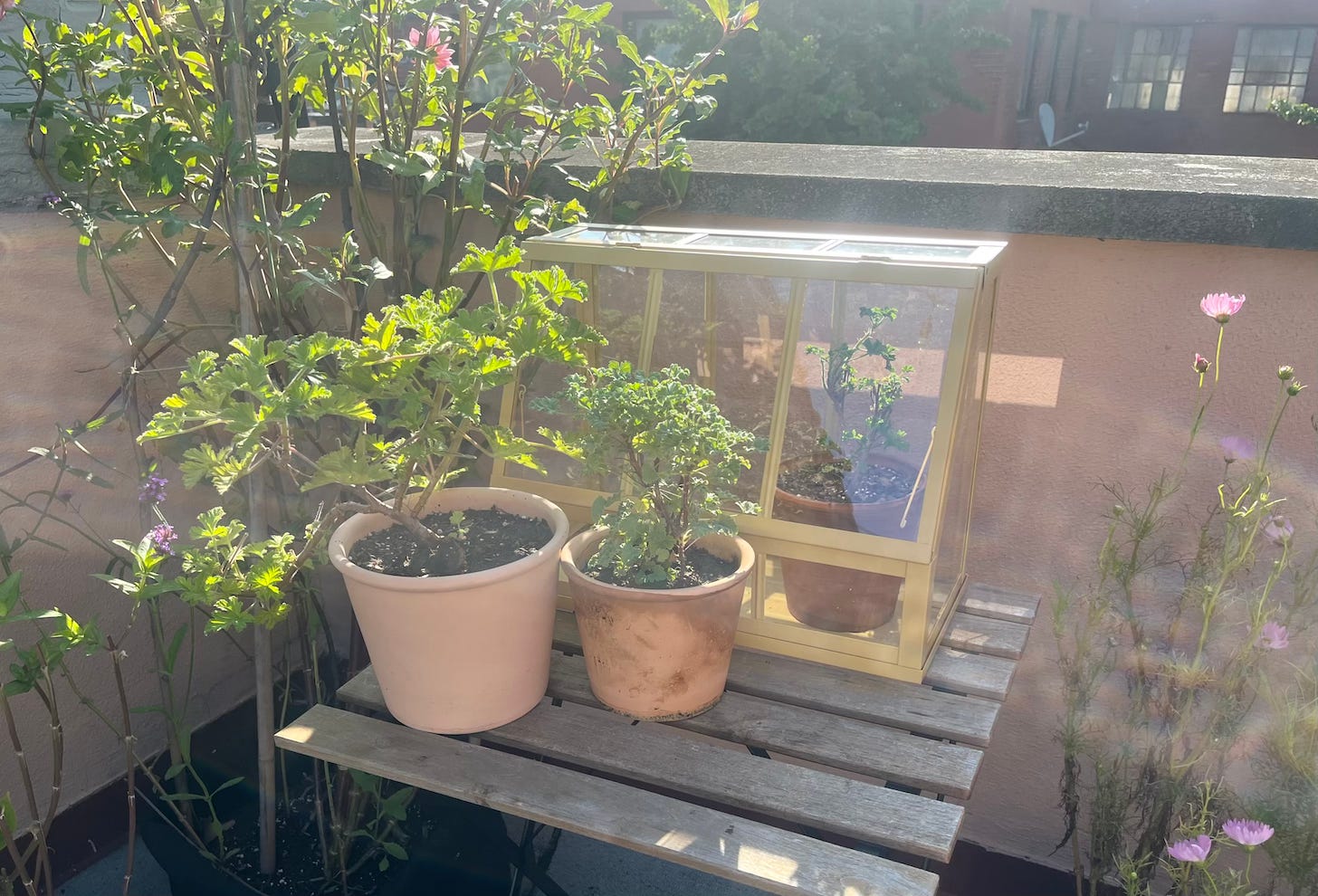
The very first plant I bought during my nomadic gardening year of 2023 was a pelargonium. Actually I bought two. It was early in the growing season, and I ordered two scented geraniums (an ‘Attar of Roses’ and a ‘Nutmeg), I think, from somewhere in Georgia, and just the act of potting them up gave me the greatest sense of hope for a future garden of some kind. I had a garden full of pots, and I’d bring them with me from place to place whenever I could, but some were large and it wasn’t always possible to take them everywhere, so sometimes I’d leave most of the plants at my parents’ house. But the two scented geraniums always came with me. And they came with me when we moved to Brooklyn. (I actually dropped and broke their pots while walking up to the apartment for the first time, but that’s another story)
What is a pelargonium, and is it a geranium? It’s a bit confusing. Apparently pelargoniums and geraniums come from the same plant family, but they’re not the same, even though they get confused for one another. Geraniums tend to be hardy and perennial—like the ‘Rozanne’ I was growing that came down with bacterial blight. I’m still sad about that one. And those annuals that you see being sold at plant nurseries and hardware stores are usually not geraniums, but pelargoniums. They include zonal, regal, ivy/trailing, and my favorite, scented, as in scented geranium. But it’s not really a geranium. See how it’s confusing?
I have one regal pelargonium—I usually call them ‘geraniums’ but let’s be proper botanists and stick to ‘pelargonium’ in this post—and the rest are scented. Scented varieties usually aren’t as showy as some of the other pelargoniums—they do flower, but their selling point is their leaves, which smell of anything from roses to fruits to nuts to mint when you rub or crush them in your hands. They’re often used in the perfume trade, and at the moment I’m very intrigued by the brand C. Atherley, which makes very aesthetically pleasing body care products using scented pelargoniums grown in the company’s greenhouse.
You can also use scented pelargoniums for culinary purposes, but I grow the plants entirely for show. I just like to look at them. They have beautiful foliage (there are so many varieties of leaf shapes and sizes) that stays looking good throughout the growing season, and if they send out a flower once in a while, I see it as a bonus. As long as I garden, I’ll keep growing pelargoniums. There are so many reasons why they make an excellent garden plant, especially if your garden, like mine, is on the small side . . .
They can be compact
The great thing about a pelargonium, both cost-wise and space-wise, is that it doesn’t like a huge pot. General advice when potting one up is to get it fairly snug in its container—it doesn’t want to go any more than two inches up in pot size. I bought my first pelargoniums as two inch plug plants, then put them into four inch terracotta pots. I replanted them a year later into slightly bigger pots, but they’re still on the small side, still very portable.
They like to be pruned back, so don’t be afraid to give them a trim, especially if they get a bit too wild for your liking. You can train them, too. I didn’t know what I was doing last year so I didn’t cut back ‘Attar of Roses’ at all, and it got very tall and very skinny. This year I pruned it back a few times, and now it’s very bushy and more compact. It likes to put out a leaning branch, which sometimes I like and sometimes I chop off. ‘Nutmeg’ has always stayed very small, and honestly probably was only repotted since I broke the first pot it was in. It’s just a little thing, with tiny leaves and tiny flowers.
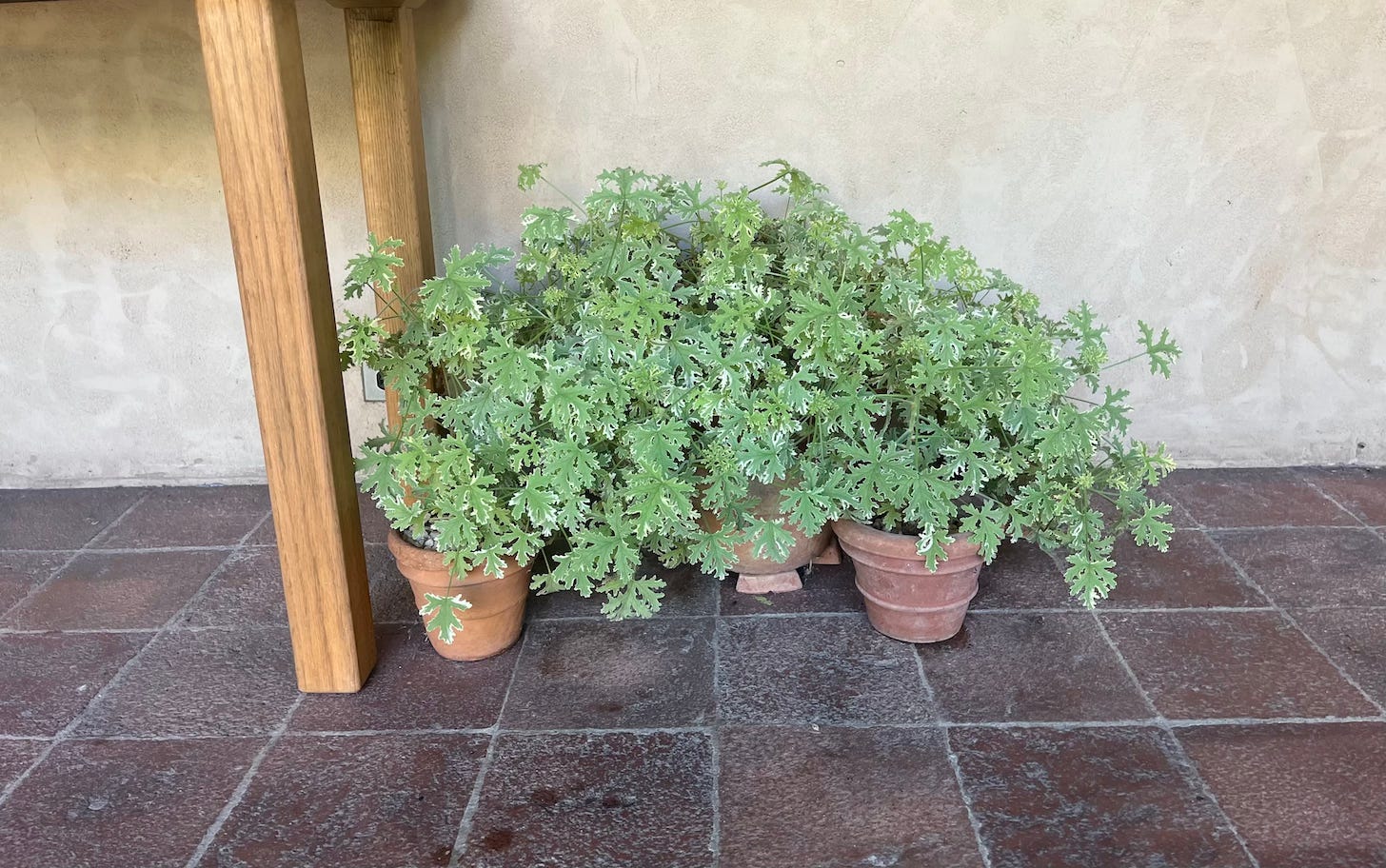
They’re easy to take care of
These are the kinds of plants that you don’t have to worry about when you go away on vacation. Pelargoniums don’t need a ton of water, even in pots. They’re mediterranean plants that like free draining soil (mix of bit of grit into your potting mix if you have it) and sunshine. I water mine a few times a week when it’s hot out, but they’re not on an everyday watering schedule like most of my garden is. And I give them seaweed fertilizer every couple of weeks or so. If a leaf looks bad, I take it off, and the plants get an occasional prune whether for fun or for cuttings (more on that soon) but that’s really about it. So easy!
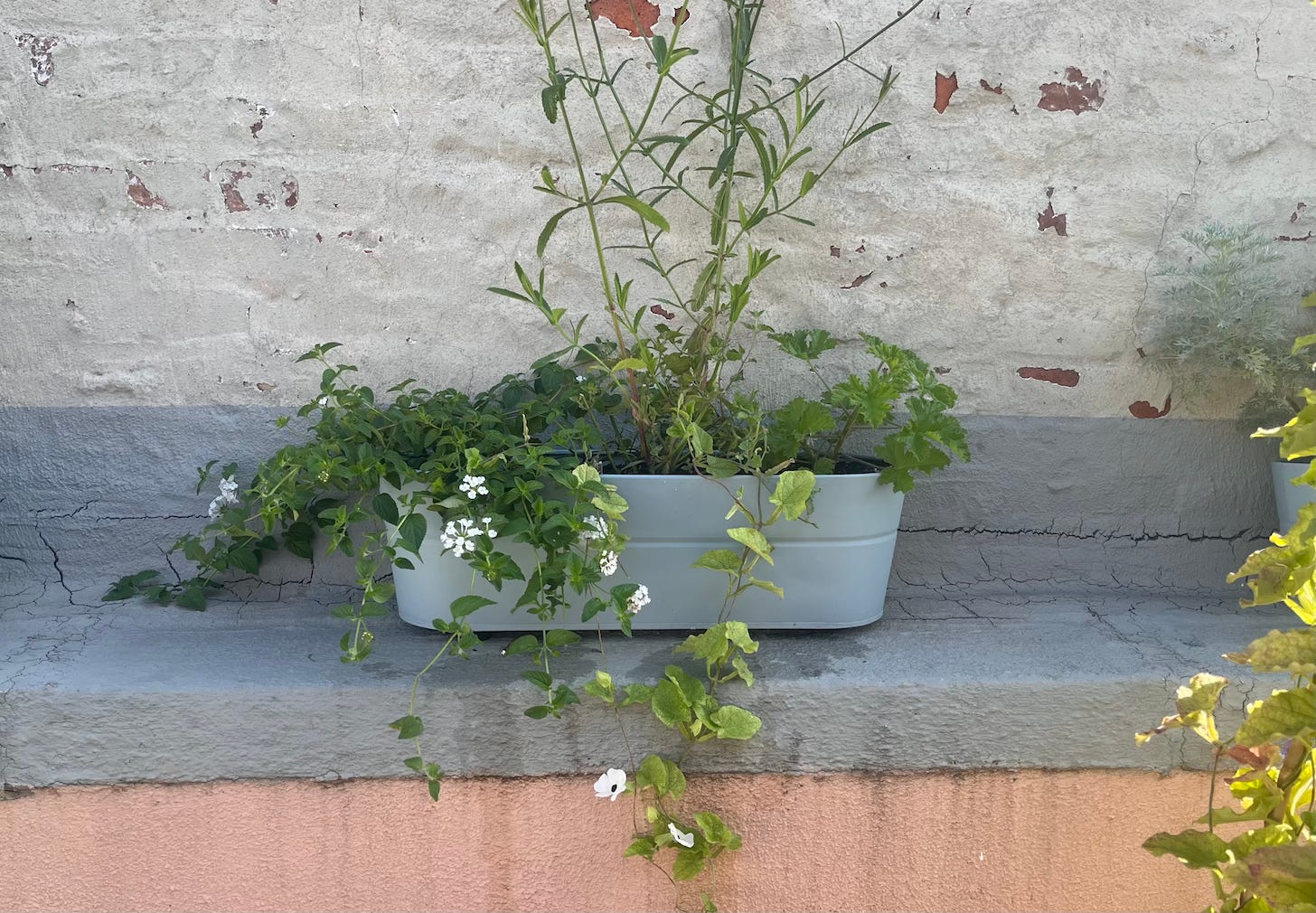
They play well with others
I do love the simplicity of a single pelargonium plant in a terracotta pot, but they also do well in mixed containers. In A Year Full of Pots Sarah Raven has a section on pelargoniums, and includes some beautiful planting combination ideas. I can see why they’d work so well with other plants, as they’re not especially hungry or thirsty, and their leaves stay green even during times when other plants start to frizzle in the sun.
I didn’t set out to do a pot combination this year using pelargoniums, but I had to replace some of my window box plants, and I’d ideally like to use plants I already have, so I put in an ‘Attar of Roses’ cutting I took back in April. It’s small now, but I’m hoping it puts on some growth in the months to come. And even if it doesn’t, at least it’s green and won’t fry up like too many of my window box plants have so far this summer. I’m learning that I need to stick to drought-tolerant plants for the window boxes, since they’re fairly small and get so much sun, and fortunately pelargoniums make good drought-tolerant plants.
They’re affordable (especially if you take cuttings!)
Scented pelargoniums have a fancy look about them—I really thought that they would be expensive. So I’m always surprised when I go to the Union Square Green Market here and see them being sold for the same price as all of the other annual pelargoniums—usually for around 6 or 7 dollars. My very favorite stall at the Green Market, Fantastic Gardens, sometimes has them for sale. And here in Brooklyn I bought a ‘Grey Lady Plymouth’ at GRDN, which also sells very beautiful Bergs pots that pelargoniums look so good in.
If you want a really large selection, though, you might have to order online. I bought some new pelargoniums a few weeks back at Geraniaceae, based out of California. They have so many varieties that it’s really hard to choose, but in the end I got two scented ones (‘Orsett’ and ‘Prince of Orange’) that, according to Sarah Raven, flower well, and also ‘Lord Bute,’ a regal variety that was already flowering away when it arrived in the mail. If you do buy from Geraniaceae, be sure to send an email first to see if they have the varieties you want in stock. This isn’t an ad, by the way. I just like them.
Of course the most affordable way to get more pelargonium plants is to take cuttings. I’m usually a failure when it comes to taking plant cuttings, but pelargoniums are so much less fussy that other plants, probably because they’re not so thirsty. You know the whole plastic bag over the pot thing to make sure the cuttings retain moisture? You don’t have to do that with pelargoniums. Most cuttings need humidity, but pelargoniums prefer dry air.
I won’t go into detail on how to take cuttings (if you’re interested, here’s a good how-to) but I’ve found that the cuttings do best kept inside, with some sunlight. I keep them on a window ledge but move them if the sun is too strong—they like sun but you don’t want them to wilt. I don’t water the cuttings until the leaves start feeling thin and start to droop a bit. I find that they’re strong plants in general, and that too much water is a lot more likely to kill them than too little water. If all goes well you’ll start seeing little baby leaves poking up around the cutting junctions, and eventually you’ll see roots coming out of the bottom of the pot. Then you can separate the cuttings and plant them into their own (small!) pots.
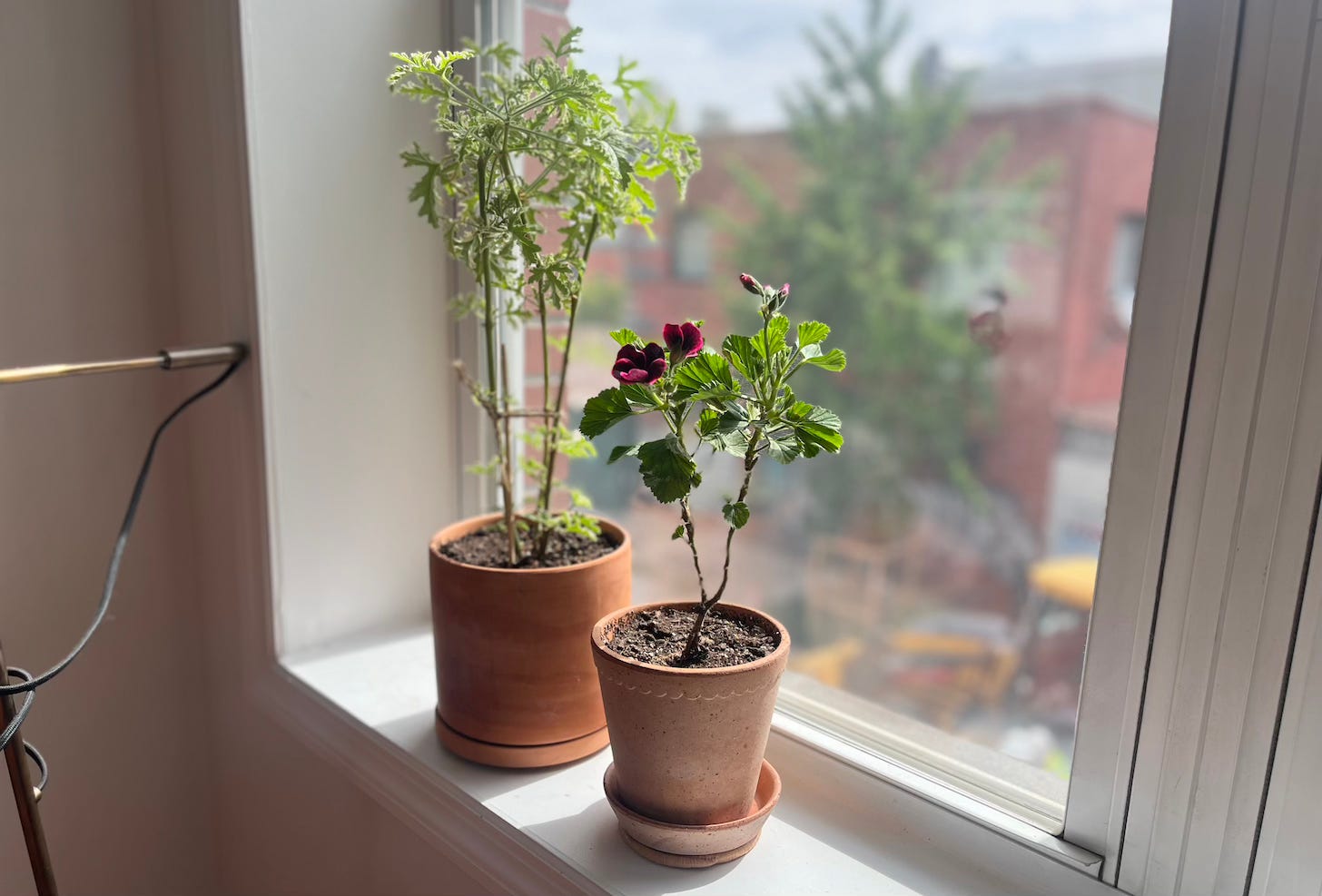
You can also keep them as houseplants
OK, so this is the real reason why I was so drawn to scented pelargoniums. I love having plants indoors, but I don’t always love what’s on offer in the houseplants section. I’m not as excited by cacti as I once was, and I don’t like tropical plants. I don’t like thick, shiny leaves. I’m sorry if you’re a houseplant person; I know I’m being picky, but it’s just how I feel. I want to grow the same kinds of plants inside that I can grow outside. It just feels like a jolt, visually, to go from Northeastern flower garden outside to tropical rainforest or California desert inside.
Pelargoniums are usually marketed as annuals since they can’t take a frost, but if you can find a way to overwinter them they’ll keep on going. Lots of people keep them in greenhouses, but if you have a sunny windowsill in your home they should do just fine. I kept ‘Attar of Roses’ and ‘Nutmeg’ inside all winter long, and they looked healthy the whole time. No flowers, but as soon as I put the plants back outside in May ‘Nutmeg’ started flowering again. ‘Attar of Roses’ has only given me one flower in the almost two years I’ve had it, but people tend to buy ‘Attar of Roses’ for its scent, not its flowers.
Supposedly the regal varieties of pelargoniums were bred especially to keep as houseplants, which I really hope is true, because I just got a ‘Lord Bute,’ and I would love for it to keep flowering all winter. But even if it doesn’t it will still look lovely.
And in case you’re not sold on pelargoniums yet, do check out interior designer Carlos Garcia’s pelargonium-filled farmhouse in Norfolk. I mean, aren’t these plants just so cheerful?






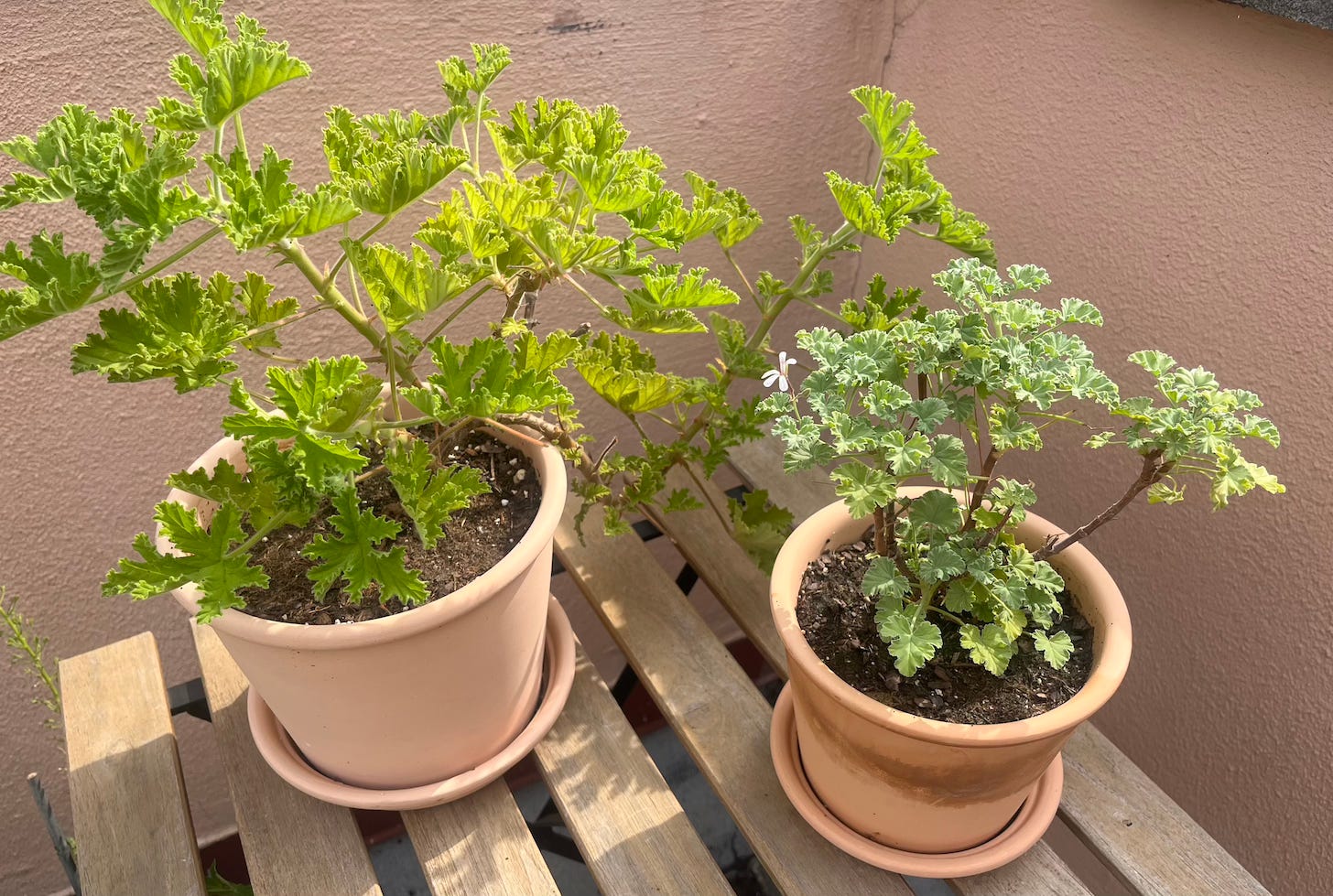



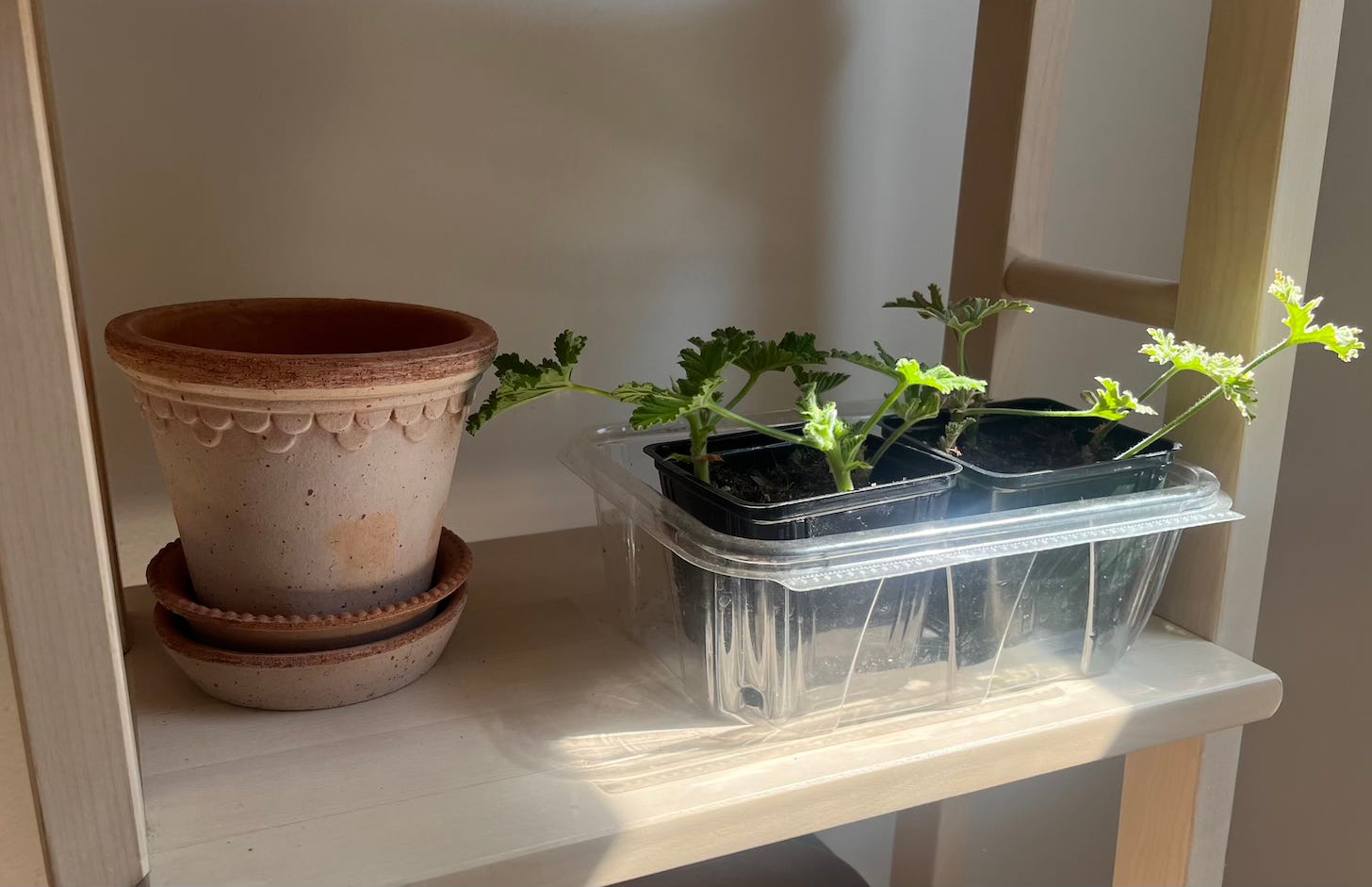


I've fallen in love with the small ones (dwarfs).
Oh, man, this was great! If I ever decide to entertain having plants/a garden, I most definitely will start with Pelargoniums. They sound like the perfect plant for me.
You mentioned them having different scents when you crush the leaves. Do they give off a scent otherwise or is that the only way to experience it?